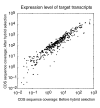Targeted next-generation sequencing of a cancer transcriptome enhances detection of sequence variants and novel fusion transcripts
- PMID: 19835606
- PMCID: PMC2784330
- DOI: 10.1186/gb-2009-10-10-r115
Targeted next-generation sequencing of a cancer transcriptome enhances detection of sequence variants and novel fusion transcripts
Abstract
Targeted RNA-Seq combines next-generation sequencing with capture of sequences from a relevant subset of a transcriptome. When testing by capturing sequences from a tumor cDNA library by hybridization to oligonucleotide probes specific for 467 cancer-related genes, this method showed high selectivity, improved mutation detection enabling discovery of novel chimeric transcripts, and provided RNA expression data. Thus, targeted RNA-Seq produces an enhanced view of the molecular state of a set of "high interest" genes.
Figures



References
-
- Zhao Q, Caballero OL, Levy S, Stevenson BJ, Iseli C, de Souza SJ, Galante PA, Busam D, Leversha MA, Chadalavada K, Rogers YH, Venter JC, Simpson AJ, Strausberg RL. Transcriptome-guided characterization of genomic rearrangements in a breast cancer cell line. Proc Natl Acad Sci USA. 2009;106:1886–1891. doi: 10.1073/pnas.0812945106. - DOI - PMC - PubMed
-
- McLendon R, Friedman A, Bigner D, Van Meir EG, Brat D, Mastrogianakis GM, Olson JJ, Mikkelsen T, Lehman N, Aldape K, Yung WK, Bogler O, Weinstein JN, VandenBerg S, Berger M, Prados M, Muzny D, Morgan M, Scherer S, Sabo A, Nazareth L, Lewis L, Hall O, Zhu Y, Ren Y, Alvi O, Yao J, Hawes A, Jhangiani S, Fowler G. Comprehensive genomic characterization defines human glioblastoma genes and core pathways. Nature. 2008;455:1061–1068. doi: 10.1038/nature07385. - DOI - PMC - PubMed
Publication types
MeSH terms
Substances
Grants and funding
LinkOut - more resources
Full Text Sources
Other Literature Sources
Molecular Biology Databases

